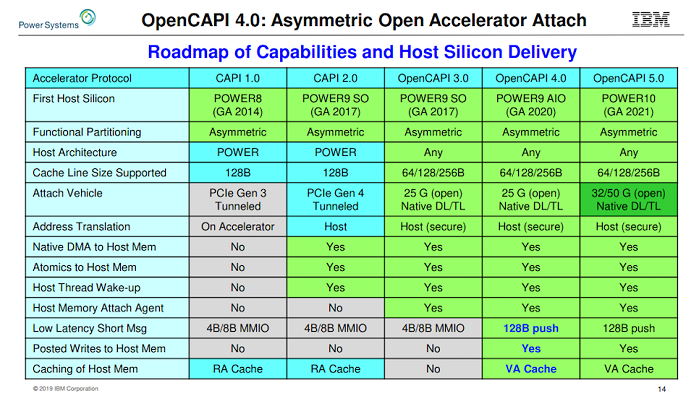IBM OpenPOWER to Join Open Source Linux Foundation

IBM has announced it was contributing the instruction set (ISA) for its Power microprocessor and the designs for the Open Coherent Accelerator Processor Interface (OpenCAPI) and Open Memory Interface (OMI) to the Linux Foundation. It also reported the OpenPOWER Foundation would become a Linux Foundation entity subject to its governance rules. Ken King, IBM general manager for OpenPOWER, made the announcements during his keynote at OpenPOWER Foundation Summit, which this year is co-located with the Linux Foundation Open Source Summit in San Diego.
Not bombshell announcements – IBM has been working with open source communities for a long time, though its $34B acquisition of Red Hat truly was a bombshell – the latest moves are nevertheless significant and reflect IBM’s efforts to leverage open source approaches to establish its Power microprocessor line and the OpenPOWER ecosystem as long-term, viable constituents of the technology landscape.
“We look at these announcements as incremental mechanisms to accelerate and drive more innovation around open hardware, hopefully some of that enabled on the Power platform and enabling even IBM to take some of that innovation [and] incorporate it back into our solutions,” King told HPCwire in a pre-briefing.
 IBM has of course enjoyed tremendous success in delivering Summit and Sierra supercomputers, now the #1 and #2 fastest computers in the world. Gaining wider traction for Power-based systems in the server market has, perhaps not unexpectedly, been more difficult. IBM touts that its Power chip line and OpenPOWER architecture are deliberately designed to leverage heterogeneous architectures – “CPUs can no longer handle the rising demands alone, and IBM’s heterogeneous systems are built to maximize the flow of data between CPUs and attached devices for specialized workloads.”
IBM has of course enjoyed tremendous success in delivering Summit and Sierra supercomputers, now the #1 and #2 fastest computers in the world. Gaining wider traction for Power-based systems in the server market has, perhaps not unexpectedly, been more difficult. IBM touts that its Power chip line and OpenPOWER architecture are deliberately designed to leverage heterogeneous architectures – “CPUs can no longer handle the rising demands alone, and IBM’s heterogeneous systems are built to maximize the flow of data between CPUs and attached devices for specialized workloads.”
Contributing the Power ISA and OpenCAPI/OMI designs to the Linux Foundation will make it easier for device and systems vendors to optimize products generally and around specific applications. IBM is licensing the Power ISA and OpenCAPI/OMI designs to the OpenPOWER Foundation which in turn will be governed by Linux Foundation rules.
“So there is a compliance requirement,” said King. “We’re trying to avoid fragmentation of the architectures which is not good for the ecosystem. But assuming compliance, anybody can implement any kind of accelerator, or controller or any other kind of hardware device on top of the instruction set, royalty-free with patent rights.” Compliance mostly means maintaining backward compatibility but even that’s not an absolute restriction.
“It won’t be IBM that makes the decision alone on changes and enhancements to the instruction set architecture. It will be done through a compliance work group where IBM only has one vote. IBM will have the rights to make changes or implementations independent of that, but anybody else will be able to incorporate changes or enhancements to it, just by a majority vote of the compliance work group,” said King. “If somebody wants to make changes to the instruction set that are not compliant, then it requires a unanimous vote.”
King’s comments on OpenCAPI/OMI and the emerging CXL effort led by Intel were startling as the two interconnect schemes jockey for sway. “I’ll be transparent about it – one of the objectives is also to try to drive convergence with CXL. When we first did OpenCAPI four or five years ago, the thought process was focused primarily on providing server reference designs enabling others to create their own server implementations on top of the architecture but not actually taking the architecture itself in opening up the rights to it.
“[But] we didn’t see the level of open hardware innovation that’s happening now in the market. We didn’t envision, you know, that a bunch of hyperscalars, and others will be creating custom hardware accelerators. But that is part of the market of evolution. [It’s] part of the need when you know you’re not getting what you need out of the processor alone. We’ve seen some things happening with RISC V that kind of validate that as well, even though RISC V is very nascent. It’s just demonstrating that the industry is ready for open hardware architectures.”
 It’s easy to wonder what “convergence” with CXL means in this context. Asked why IBM doesn’t simply join CXL, King advised to keep an eye on this space. Comments by IBMer Jeff Stuecheli at Hot Chips, going on now, discussing details of OpenCAPI 4.0 were seemingly dismissive of CXL. Time will tell.
It’s easy to wonder what “convergence” with CXL means in this context. Asked why IBM doesn’t simply join CXL, King advised to keep an eye on this space. Comments by IBMer Jeff Stuecheli at Hot Chips, going on now, discussing details of OpenCAPI 4.0 were seemingly dismissive of CXL. Time will tell.
IBM’s embrace of open source began in earnest in 2013 with formation of the OpenPOWER Foundation, which is led by IBM, Mellanox, Nvidia, and now Red Hat. Since then IBM says it has “contributed thousands of development hours to both contribute and co-create thousands of pages of documentation around the POWER architecture.” Also implied amid the changes is IBM’s recognition that its AIX (Unix) market, though sizeable, is declining versus Linux’s rise and dominance, yet another win for open source.
Overall, said King, “IBM is the only processor vendor in the world that is open end to end from, the ISA to the firmware to the operating system, to the cloud container management all the way up the server stack, [and] the only truly open architecture in the ecosystem. We’re excited about this announcement in following the Red Hat [acquisition which] closed earlier this year, and what we think this will do for the ecosystem from an innovation perspective.”
One representative example is a new serial memory controller from Microchip, an OpenCAPI Consortium member, that was co-developed with IBM using OMI. According to Microchip, the new controller enables CPUs and other compute-centric devices to utilize four times the memory channels within the same device footprint. “Microchip is excited to introduce the industry’s first serial memory controller device to the market,” said Pete Hazen, vice president of the Data Center Solutions business unit at Microchip’s Microsemi subsidiary. “New memory interface technologies such as Open Memory Interface (OMI) enable a broad range of applications to support the increasingly demanding memory requirements of high-performance data center applications.”
IBM rounded up testimonials from several constituencies in support of the new moves. Here’s a sampling:
- “Hitachi joined the OpenPOWER Foundation because we believe that an open ecosystem enabled with the latest technology will drive client value,” said Nobuhiro Kato, Vice President, IoT & Cloud Services Business Division, Hitachi, Ltd. “Today’s announcement from IBM underscore the open momentum and we look forward to accelerating open innovation to help our clients succeed.”
- “Mellanox and IBM have had deep technological collaborations over the years, culminating in building the world’s fastest supercomputers and leading cloud and enterprise data centers,” said Chuck Tybur, senior vice president of worldwide OEM & channel sales at Mellanox Technologies. “Mellanox is a top open-source software contributor, and believes in open standards and community development efforts. We are proud members of the OpenPOWER and OpenCAPI organizations, and are looking forward to continue our contributions in the future.”
- “As one of the first public clouds to offer the POWER architecture for High Performance Computing and Deep Learning applications, and the first to support unique CAPI-accelerated workloads, we areexcited to see the next big evolution as these technologies move to open source,” said Steve Hebert, CEO, Nimbix. “The Nimbix JARVICE XE multi-cloud platform and HyperHub marketplace have day one support for both Power and CAPI workloads.”
- “Nvidia’s support of open ecosystems has helped ignite an era of innovation powered by our GPU-accelerated computing platform,” said Marc Hamilton, vice president of Solutions Architecture and Engineering at Nvidia. “IBM’s continued efforts to enable the open community with enterprise-grade hardware designs provides welcome flexibility and choice to Nvidia’s community of more than 1.3 million active developers worldwide.”
- “As our industry continues to evolve, the open hardware communities will grow as evidenced in IBM’s announcement,” said Zvonimir Bandic, chairman of the OpenCAPI Consortium and chairman of the CHIPS Alliance. “Since its inception in 2016, the OpenCAPI Consortium has been a supporter of this direction while we also continue to investigate how we grow this community and further this strategy through engagement with other open source hardware organizations.”
- “Xilinx believes that an open community spawns more innovation,” said Donna Yasay, vice president of marketing, Data Center Group, Xilinx, Inc. “We believe that IBM’s move to contribute its POWER ISA and key hardware reference designs to the open source community, and now under the guidance of the Linux Foundation, will enable a broader ecosystem with better technology and platforms to solve critical computing challenges today and in the future.”
- “The slowing down of Moore’s Law provides the open source community with the opportunity to develop innovative hardware that improves performance while reducing development and manufacturing costs,” said Bapi Vinnakota, director of silicon architecture at Netronome and the Open Compute Project’s (OCP) Open Domain Specific Architecture (ODSA) Sub-Project Lead.“IBM’s opening of the POWER ISA, along with open sourcing reference designs, shares the ODSA’s mission of enabling customers to bring open, cost-efficient, low-power accelerator products to market.”
- Jim Zemlin, executive director of the Linux Foundation, said, “Back in 2013 we were excited to see IBM took the first steps in opening the company’s POWER architecture. The Linux Foundation itself has seen rising interest in open hardware communities and working with OpenPOWER Foundation will continue to make the OpenPOWER and open hardware technologies available to a growing, global audience.”
Many familiar names in the server OEM world have yet to embrace OpenPOWER – e.g. Dell, HPE, Cray, Lenovo – and it will be interesting to monitor how they respond to the latest changes.
Note: This originally appeared in sister publication HPCwire, whose managing editor, Tiffany Trader, contributed to the reporting for this article.










